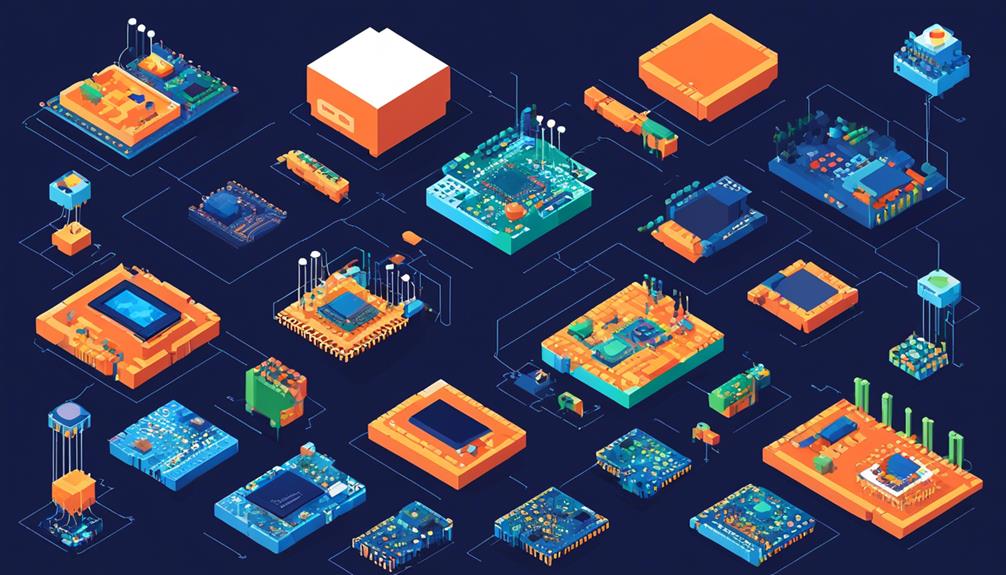In the ever-evolving landscape of IoT, designing hardware for scalability is a critical aspect that cannot be overlooked. The ability to seamlessly transition from prototype to production is paramount, and it requires careful consideration of numerous factors.
From ensuring quick iteration on hardware design to addressing challenges like security threats and device management, the path to scalable IoT hardware is paved with technical precision and attention to detail. But how can one navigate these challenges successfully? What strategies can be employed to overcome the hurdles that scalability presents?
In this discussion, we will explore the importance of IoT scalability, the common challenges faced in hardware scalability, and delve into the strategies and solutions that can help pave the way for a successful deployment.
Key Takeaways
- Scalability in IoT hardware design is crucial for efficiently handling a large number of connected devices and data load.
- Designing hardware with modularity and interoperability allows for easy customization and adaptability.
- Incorporating scalable processing power and dynamic resource allocation enables IoT systems to adjust to changing demands.
- Optimizing hardware design and production processes, considering factors such as cost, reliability, and power efficiency, helps create scalable hardware solutions.
Importance of Iot Scalability

Scalability plays a critical role in the success of IoT systems, allowing them to handle a vast number of connected devices and data load efficiently. The ability to scale an IoT system is essential for responding to changing demands, saving time and money in IoT projects. By designing an IoT system with scalability in mind, organizations can future-proof their deployments and ensure long-term success.
One of the key benefits of scalability in IoT systems is the ability to handle a large number of connected devices. As the number of devices connected to an IoT network increases, the system needs to be able to handle the additional data load and processing requirements. Scalability enables the system to scale up its resources, such as processing power and storage capacity, to meet the growing demands.
Furthermore, a flexible scalability strategy allows for scaling back or ramping up data processing according to requirements. This flexibility is crucial in IoT systems, where the data load can vary significantly depending on factors such as time of day, location, and user activity. By being able to dynamically adjust the resources allocated to data processing, organizations can optimize their system performance and ensure efficient use of resources.
Scalability also helps prevent project failure in IoT, which is often caused by gaps in expertise or complicated scaling processes. By designing an IoT system with scalability in mind from the beginning, organizations can avoid these challenges and ensure a smooth scaling process. This includes considering factors such as the ability to add or remove devices easily, supporting distributed data processing, and implementing efficient communication protocols.
Common Challenges in Iot Hardware Scalability
One of the common challenges in IoT hardware scalability is connectivity. As the number of connected devices increases, ensuring reliable and seamless connectivity becomes crucial.
This involves addressing issues such as network coverage across vast areas, cellular connectivity in remote locations, and the ability to handle a large number of devices simultaneously.
Additionally, resource limitations can pose challenges in terms of processing power, memory, and energy consumption, requiring efficient hardware design and optimization techniques.
Connectivity Challenges
Connectivity challenges in IoT hardware scalability present significant obstacles that require careful consideration and strategic planning to ensure seamless and uninterrupted data flow. These challenges arise due to various factors such as device management, integration complexities, and the need for reliable cellular coverage.
Device management becomes challenging after deployment, as IoT devices require regular updates and security patches to ensure optimal performance and protection against vulnerabilities.
The integration of hardware, software, and connectivity can be complicated and time-consuming, requiring meticulous planning and coordination to ensure compatibility and interoperability.
Ensuring cellular coverage across vast geographic areas is difficult but crucial for uninterrupted data flow. Reliable connectivity is essential for real-time communication and data transmission between IoT devices and the cloud.
Addressing these connectivity challenges is vital to the success of IoT projects, as they directly impact the reliability, scalability, and security of the overall system.
Resource Limitations
After addressing the connectivity challenges in IoT hardware scalability, the next crucial aspect to consider is the resource limitations that commonly arise in IoT hardware design. IoT devices often face constraints in processing power, memory, and energy efficiency. Power consumption must be optimized to ensure devices can operate for extended periods without frequent battery changes. Memory constraints require efficient data storage and management to handle large volumes of sensor data. Processing power limitations demand careful consideration of algorithms and computational efficiency. Balancing these resource limitations with functionality and performance requirements is a key challenge in IoT hardware scalability.
| Resource Limitation | Challenges | Solutions |
|---|---|---|
| Processing Power | Limited computational capabilities | Use lightweight algorithms |
| Memory | Insufficient storage for sensor data | Implement efficient data management |
| Energy Efficiency | High power consumption | Optimize power usage |
Security Considerations for Scalable Iot Hardware

Security considerations play a crucial role in ensuring the scalability and integrity of IoT hardware systems. As scalable IoT architectures continue to evolve, it is important to address security threats and implement robust measures to protect the devices and the data they handle.
Here are three key security considerations for scalable IoT hardware:
- Secure Communication Protocols: Implementing secure communication protocols is vital for protecting data transmission in scalable IoT hardware. By utilizing encryption and authentication mechanisms, data can be securely transmitted and received, reducing the risk of unauthorized access or data breaches.
- Secure Boot Methods: Unauthorized firmware modifications can introduce vulnerabilities and compromise the integrity of scalable IoT devices. Implementing secure boot methods ensures that only authorized and authenticated firmware can be loaded onto the devices, preventing unauthorized modifications and ensuring the authenticity of the firmware.
- Device Authentication and Authorization Mechanisms: Controlling access and preventing unauthorized use is crucial in scalable IoT systems. Implementing robust device authentication and authorization mechanisms allows only authorized devices to connect and access the system, reducing the risk of unauthorized access and potential security breaches.
To enhance the overall security of scalable IoT devices, regular security updates and patches are essential. As security threats evolve, it is important to address vulnerabilities promptly by regularly updating the firmware and software on the devices. Additionally, incorporating hardware-based security features, such as secure elements and trusted platform modules, can provide additional layers of security and protection against various exploits.
Device Management Strategies for Scalability
When designing IoT hardware for scalability, it is essential to consider device management strategies such as remote device monitoring and over-the-air updates.
Remote device monitoring allows for real-time monitoring of device performance and health, enabling proactive maintenance and issue resolution.
Over-the-air updates enable firmware and software updates to be deployed remotely, ensuring that devices stay up-to-date with the latest features and security patches without the need for physical intervention.
These device management strategies play a crucial role in ensuring the scalability and efficiency of IoT hardware deployments.
Remote Device Monitoring
Remote Device Monitoring is a crucial aspect of IoT hardware design, enabling centralized tracking and management of distributed devices for real-time status checks, updates, and proactive maintenance. Implementing remote device monitoring is essential for ensuring the scalability of IoT deployments.
Here are three key benefits of remote device monitoring for IoT scalability:
- Efficient Management: Remote device monitoring allows for seamless and efficient management of large fleets of devices. It provides a single interface for monitoring the health, security, and performance of distributed IoT devices.
- Proactive Maintenance: With remote device monitoring, organizations can proactively identify and address issues before they escalate. This minimizes downtime and optimizes device performance, ensuring the smooth operation of IoT deployments.
- Real-Time Updates: Remote device monitoring enables real-time status checks and updates for distributed devices. This ensures that devices are always up-to-date with the latest firmware, security patches, and configurations, improving overall system reliability and security.
Over-The-Air Updates
To ensure seamless device management and scalability in IoT deployments, implementing efficient device management strategies such as Over-The-Air (OTA) updates is crucial. OTA updates allow for remote updating of firmware and security patches in IoT devices, reducing maintenance costs and enabling quick deployment of updates to a large number of devices.
However, implementing OTA updates requires robust integration of hardware, software, and connectivity to ensure seamless device management. Reliable OTA services play a significant role in ensuring quick and seamless updates for a scalable IoT deployment.
With OTA updates, IoT hardware can easily receive new functionalities and bug fixes, ensuring that devices are always up-to-date and able to adapt to changing requirements. This not only improves the overall performance and reliability of IoT deployments but also allows for easy scalability as new devices can be added and updated without manual intervention.
Addressing Cellular Coverage in Iot Scalability

Addressing the challenge of cellular coverage in IoT scalability requires designing IoT hardware with scalable and comprehensive cellular connectivity across different geographic areas. This is crucial to ensure uninterrupted data flow and reliable communication between IoT devices and the cloud.
To address cellular coverage in IoT scalability, consider the following:
- Obtain regional certifications: When designing IoT hardware, it's important to ensure compliance with regional regulations and certifications. This includes obtaining certifications for different geographic areas to ensure that the IoT devices can operate seamlessly across various regions.
- Find new carriers: Collaborating with multiple cellular carriers is essential to address coverage challenges. By partnering with carriers that have extensive coverage in different regions, IoT devices can achieve comprehensive cellular connectivity and ensure seamless data transmission.
- Implement IoT-specific SIM cards: IoT-specific SIM cards can provide streamlined and reliable cellular connectivity. These SIM cards are designed specifically for IoT devices, offering features such as remote provisioning, secure connections, and simplified management. By using IoT-specific SIM cards, IoT devices can easily connect to cellular networks, regardless of their location.
Issues Specific to Large-Scale Iot Deployments
As large-scale IoT deployments continue to expand, several issues specific to these deployments arise that require careful consideration and strategic planning.
One of the primary challenges is the ability to scale the infrastructure and cloud services to accommodate the increasing number of devices. With a large-scale IoT deployment, the number of connected devices can reach millions, and the infrastructure must be capable of handling the massive influx of data and interactions.
Another issue specific to large-scale IoT deployments is the geographic expansion. As the deployment expands to cover larger areas, finding new carriers and obtaining regional certifications becomes crucial. This ensures that the devices can connect to the network seamlessly and comply with local regulations.
Security threats also increase as the number of connected devices grows in large-scale IoT deployments. With a larger attack surface, there is a higher risk of cyber-attacks and breaches. Robust security measures, such as strong encryption protocols, authentication mechanisms, and intrusion detection systems, are essential to protect the devices and the data they generate.
Over-the-air updates and device management become complex and challenging after deployment in large-scale IoT deployments. With a vast number of devices spread across different locations, ensuring that all devices receive timely updates and can be managed effectively requires advanced device management solutions. These solutions must be capable of managing devices remotely, tracking their status, and deploying updates securely.
Lastly, ensuring reliable cellular coverage across vast geographic areas is crucial for uninterrupted data flow in large-scale IoT deployments. This requires strategic planning to select carriers that have broad coverage and strong network infrastructure in the deployment areas.
Elasticity and Scalability in Iot Hardware

Elasticity and scalability are crucial aspects of IoT hardware design.
Flexibility in IoT hardware allows for dynamic resource allocation, enabling seamless adjustment and expansion of resources based on changing demands.
This capability is essential for accommodating a growing number of connected devices and handling sudden spikes in data processing and communication requirements.
Flexibility in IoT Hardware
How can IoT hardware be designed to achieve flexibility and scalability in order to accommodate the ever-changing demands of the IoT ecosystem?
In order to address this question, there are several key considerations that need to be taken into account:
- Modularity: Designing IoT hardware with modular components allows for easy customization and adaptability to different use cases and requirements. This enables scalability as new modules can be added or existing ones can be upgraded without having to replace the entire hardware.
- Interoperability: Ensuring that IoT hardware is compatible with various communication protocols and standards allows for seamless integration with other devices and systems. This enhances flexibility by enabling the hardware to work with different IoT ecosystems and platforms.
- Scalable Processing Power: Incorporating hardware components that can handle increasing data processing requirements is essential for scalability. This can be achieved by using powerful processors, expandable memory, and efficient data storage solutions.
Dynamic Resource Allocation
To ensure adaptability and efficient resource allocation in IoT hardware, dynamic resource allocation plays a crucial role. This approach allows IoT systems to dynamically adjust their resource allocation based on changing demands, ensuring optimal performance and resource utilization.
Elasticity, a key aspect of dynamic resource allocation, enables IoT hardware to scale its resources up or down as needed. By efficiently allocating resources, IoT hardware can handle varying workloads and maintain consistent performance levels.
Moreover, dynamic resource allocation helps reduce costs in IoT hardware deployments by optimizing resource usage. It also future-proofs IoT hardware against evolving demands and technologies, ensuring that the system remains scalable and adaptable in the face of changing requirements.
Global Scaling Considerations for Iot Hardware
Global scaling considerations for IoT hardware involve seamlessly transitioning from prototype to large-scale production while ensuring infrastructure, cloud, and connectivity for scalable deployment, as well as obtaining regional certifications and finding new carriers for expansion into new geographic areas.
Scaling IoT projects globally requires careful planning and execution to ensure successful deployment and operation. Here are some key considerations for global scaling of IoT hardware:
- Hardware design and production: When scaling IoT hardware, it is crucial to optimize the design and production processes. Quick iterations on hardware design and efficient manufacturing techniques can help streamline the production of large quantities of devices. Additionally, considering factors such as cost, reliability, and power efficiency during the design phase can lead to more scalable hardware solutions.
- Infrastructure and connectivity: To ensure scalable deployment of IoT hardware, it is important to have a robust infrastructure and reliable connectivity in place. This includes setting up cloud-based platforms and data storage systems that can handle the increased data volume generated by a large number of devices. Additionally, choosing the right connectivity options, such as cellular or LPWAN technologies, can enable seamless communication between devices and the cloud.
- Regional certifications and carriers: When expanding into new geographic areas, it is essential to obtain the necessary regional certifications and comply with local regulations. These certifications ensure that the IoT devices meet specific safety, security, and interoperability standards. Furthermore, finding new carriers in different regions is crucial for ensuring connectivity and network coverage for the deployed IoT devices.
Scaling IoT hardware globally requires careful planning and consideration of various factors such as hardware design, infrastructure, connectivity, and regional requirements. By addressing these considerations, organizations can successfully deploy and operate IoT devices on a large scale, enabling them to harness the potential of IoT technologies for their business needs.
Efficient Scaling Techniques for Iot Hardware

Efficient scaling techniques for IoT hardware involve implementing modular and standard-based approaches to handle diverse devices and protocols. With the increasing number of IoT devices and the need for seamless integration, scalability becomes a critical consideration.
One efficient technique is the implementation of edge computing, which distributes data processing closer to the source, reducing latency and enabling better scalability. By performing computations at the edge of the network, IoT devices can offload processing tasks, allowing for efficient scaling in terms of both computing power and network bandwidth.
Load balancers are another important tool for efficient scaling. They evenly distribute incoming traffic across multiple servers, preventing bottlenecks and ensuring that each server can handle its fair share of requests. With load balancers in place, the system can handle higher loads and accommodate a growing number of IoT devices without compromising performance.
Choosing the right database is also crucial for efficient scaling. Distributed databases, such as NoSQL databases, can scale horizontally by adding more nodes to the cluster. This allows for the handling of the increasing volume of IoT data without sacrificing performance. By leveraging distributed databases, IoT systems can efficiently store and retrieve data from a large number of devices, ensuring scalability as the number of connected devices grows.
Furthermore, implementing message queues can facilitate efficient scaling by enabling asynchronous communication between different components. Message queues decouple services, allowing them to process data independently and at their own pace. This decoupling improves scalability by reducing dependencies and enabling each component to scale independently based on its specific requirements.
Easy-To-Use APIs for Scalable Iot Hardware
Easy-to-use APIs play a crucial role in the scalability of IoT hardware. These APIs provide a streamlined approach for integrating hardware with software applications, enabling seamless interactions and efficient development.
API Usability for Scalability
API usability is a critical factor in ensuring seamless integration and efficient deployment of scalable IoT hardware. Well-designed APIs enable quick iteration on hardware design, allowing for efficient scalability. Easy-to-use APIs simplify the process of deploying IoT hardware globally, reducing the time and effort required for integration.
API usability plays a crucial role in ensuring that infrastructure, cloud, and connectivity can scale with IoT hardware deployment, enabling the efficient management of large-scale IoT deployments. Scalable IoT hardware requires easy-to-use APIs for rapid integration and deployment, as they provide a standardized interface for communication and data exchange, making it easier for developers to work with the hardware.
Effective API usability is essential for the successful scalability and widespread adoption of IoT hardware.
Streamlined Hardware Integration
Streamlined hardware integration is crucial for the successful deployment and scalability of IoT solutions. It enables efficient and simplified setup and integration processes. Easy-to-use APIs play a significant role in achieving this goal.
These APIs allow for seamless integration of IoT hardware into existing systems, ensuring that the hardware can be easily incorporated without requiring extensive modifications or complex configurations. With streamlined hardware integration, quick prototyping and production become possible through simplified setup and integration processes.
Additionally, APIs designed for scalability provide flexibility in porting firmware across different hardware platforms effortlessly, further enhancing the scalability of IoT solutions. Over-the-air (OTA) services ensure quick and seamless updates for any number of IoT devices, further enhancing scalability.
Furthermore, the use of pre-certified hardware and pre-negotiated carrier partnerships simplifies global cellular connectivity, aiding in the scalable deployment of IoT solutions.
Streamlined Cellular Connectivity for Scalability

Efficient and seamless cellular connectivity is crucial for enabling scalable IoT deployments across diverse geographic locations. To achieve this, IoT hardware needs to incorporate streamlined cellular connectivity solutions that simplify the complexities of connecting devices to cellular networks.
Here are three key elements that contribute to streamlined cellular connectivity for scalability:
- Pre-certified hardware and carrier partnerships: The use of pre-certified hardware and established partnerships with cellular carriers can greatly simplify the process of achieving global coverage for IoT devices. By leveraging these partnerships, IoT hardware manufacturers can ensure that their devices are compatible with multiple networks, eliminating the need for separate certification processes and enabling seamless connectivity across different regions.
- IoT-specific SIM cards: IoT-specific SIM cards, such as Particle's EtherSIM, offer versatile connectivity options for IoT deployments. These SIM cards can connect to multiple networks, allowing devices to switch between different cellular providers based on signal strength and availability. This flexibility ensures reliable connectivity, even in areas with limited coverage or network congestion, making it easier to scale IoT deployments across diverse locations.
- Support for multiple technologies: Particle's cellular connectivity suite supports a range of technologies, including WiFi, 2G, 3G, and LTE. This versatility allows IoT hardware to adapt to different network infrastructure and availability, ensuring that devices can connect regardless of the cellular technology used in a particular region. By supporting multiple technologies, IoT deployments can scale more effectively, as they are not limited by the availability of a specific network type.
In addition to these features, reliable over-the-air (OTA) update services are crucial for maintaining scalability in IoT deployments. With international accessibility, Particle's OTA update services ensure that firmware updates can be efficiently and consistently delivered to IoT devices, keeping them secure and up to date.
Ensuring Security in Scalable Iot Hardware
To ensure the scalability of IoT hardware, it is imperative to prioritize the implementation of robust security measures against potential threats. System security is a critical aspect of designing scalable IoT hardware, as it protects sensitive data and ensures the integrity of the entire system. Implementing end-to-end encryption and obtaining SOC II and GDPR certifications are essential steps in safeguarding IoT devices from unauthorized access and data breaches.
Incorporating over-the-air update capabilities is crucial for seamless firmware and security patch distribution in IoT device management. This feature enables manufacturers to remotely update the software of their devices, ensuring that any vulnerabilities or bugs are promptly addressed. It also allows for the deployment of security patches and feature enhancements without the need for physical access to the devices, making it easier to manage a large-scale IoT deployment securely.
Simplifying connectivity and ensuring global coverage is another vital aspect of securing scalable IoT hardware. By utilizing pre-certified hardware and IoT-specific SIM cards, manufacturers can ensure that their devices can connect to networks worldwide, while also providing built-in security features. These SIM cards can be provisioned and managed remotely, enabling secure and reliable communication between devices and the central IoT platform.
To handle the increasing data volume and reduce latency in scalable IoT deployments, it is essential to choose distributed databases and implement edge computing. Distributed databases allow for efficient storage and retrieval of data from multiple locations, while edge computing enables processing and analysis of data closer to the devices, reducing the need for data transmission to a centralized server. These strategies enhance system security by minimizing the exposure of sensitive data during transit and reducing the risk of data breaches.
In summary, ensuring security in scalable IoT hardware requires a comprehensive approach that incorporates encryption, certifications, over-the-air updates, simplified connectivity, distributed databases, and edge computing. By prioritizing these measures, manufacturers can build robust and secure IoT systems that can seamlessly scale to meet the demands of the future.
| Security Measures | Description |
|---|---|
| End-to-end encryption | Protects data from unauthorized access by encrypting it throughout its transmission and storage. |
| SOC II and GDPR certifications | Demonstrates compliance with industry standards and regulations regarding security and privacy. |
| Over-the-air updates | Enables remote firmware and security patch distribution, ensuring devices are always up to date. |
| Simplified connectivity | Utilizes pre-certified hardware and IoT-specific SIM cards for secure and reliable global connectivity. |
| Distributed databases | Allows for efficient storage and retrieval of data from multiple locations, enhancing data security. |
| Edge computing | Enables data processing and analysis closer to the devices, reducing latency and minimizing data exposure. |
Simplifying the Supply Chain for Scalable Iot Hardware

Simplifying the supply chain for scalable IoT hardware involves optimizing the procurement process and partnering with providers to ensure efficient access to hardware components. By streamlining the supply chain, companies can effectively scale their IoT hardware and ensure a seamless production process.
Here are three key strategies for simplifying the supply chain for scalable IoT hardware:
- Centralized procurement: Adopting a centralized approach to procurement allows companies to consolidate their purchasing power and negotiate better deals with suppliers. By partnering with a select group of trusted providers, companies can streamline the procurement process and ensure a steady supply of hardware components. This approach also enables companies to maintain clear visibility into their inventory levels and make informed decisions about replenishment.
- Module partnerships: Collaborating with module providers can simplify the supply chain by providing pre-certified and pre-integrated hardware modules. These modules can be easily incorporated into IoT devices, reducing the time and effort required for hardware enhancements. By leveraging the expertise of module providers, companies can expedite the development process and accelerate time to market.
- Risk mitigation: Simplifying the supply chain also involves mitigating risks associated with supply chain disruptions. Companies should establish backup suppliers and maintain a diversified network of providers to ensure a continuous supply of hardware components. Additionally, implementing robust inventory management systems and leveraging data analytics can help identify potential bottlenecks and proactively address supply chain challenges.
Overcoming Challenges in the POC Phase of Iot Projects
During the Proof of Concept (POC) phase of IoT projects, one of the key challenges is to identify and address scalability issues early on. Ensuring that both hardware and software components are capable of scaling to production levels is crucial during this phase. Successful POC phase requires streamlining device management, security, and connectivity to anticipate potential scalability challenges in the future. By testing and validating the scalability of the IoT solution during the POC phase, potential roadblocks in the production phase can be avoided. Addressing potential scaling challenges in the POC phase ensures a smoother transition to large-scale deployment in IoT projects.
To emphasize the importance of addressing scalability issues during the POC phase, the following table illustrates some potential challenges and corresponding strategies to overcome them:
| Challenge | Solution |
|---|---|
| Limited hardware resources | Optimize code and algorithms to reduce resource usage. Consider upgrading hardware if necessary. |
| Inefficient data processing | Implement distributed computing techniques such as edge computing to handle large volumes of data efficiently. |
| Connectivity issues | Test and validate the connectivity of devices in different environments to ensure seamless communication. Consider redundancy and fallback mechanisms for uninterrupted connectivity. |
| Security vulnerabilities | Conduct thorough security testing to identify and address potential vulnerabilities. Implement robust security measures such as encryption, authentication, and access control. |
Frequently Asked Questions
What Is Scalability in Iot?
Scalability in IoT refers to the ability of IoT systems and devices to handle increasing data volumes, user demands, and geographical expansions without compromising performance. It involves overcoming scalability challenges such as hardware limitations, network bandwidth, and data processing capabilities.
Benefits of scalable IoT devices include improved efficiency, cost-effectiveness, and the ability to support growing user bases. By designing IoT hardware with scalability in mind, organizations can ensure seamless transitions from prototypes to production and meet the demands of global deployment.
What Are the Four Components Required to Design Iot Device?
To design an IoT device, four essential components are required: sensors, microcontrollers, connectivity, and power management.
Sensors play a crucial role in data collection, ranging from temperature and humidity to motion and environmental measurements.
Microcontrollers act as the device's brain, handling data processing, control, and communication with other components.
Connectivity is necessary for wireless communication with the internet or other devices, achieved through technologies like Wi-Fi, Bluetooth, or cellular networks.
Power management involves selecting suitable power sources and implementing efficient usage to ensure extended battery life or continuous operation.
What Are the Hardware Requirements for Iot?
IoT hardware requirements include components such as:
- Microcontrollers
- Sensors
- Actuators
for data collection and control.
Connectivity is crucial, and IoT devices should support wireless communication protocols like:
- Wi-Fi
- Bluetooth
- Zigbee
- LoRa
Power efficiency is also a key consideration, with:
- Low-power microcontrollers
- Energy harvesting modules
being essential.
Reliability is important, with hardware designed to withstand environmental conditions and long-term use.
Scalable IoT hardware should have modular and expandable designs to accommodate future upgrades and new features.
How to Design an Iot Device?
When designing an IoT device, there are several principles and factors to consider.
Firstly, it's important to define the device's purpose and intended functionality.
Next, one must select the appropriate hardware components and connectivity options to meet those requirements.
Additionally, factors such as power consumption, form factor, and cost should be considered.
Furthermore, ensuring compatibility with existing IoT platforms and addressing security and privacy concerns are crucial.
